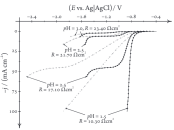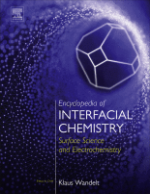
Electrochemical Hydrogen Evolution: H+ or H2O Reduction? A Rotating Disk Electrode Study
The paper authored by
V. Grozovski,
S. Vesztergom,
G.G. Láng and
Peter Broekmann
is published in Journal of the Electrochemical Society (2017, vol. 164, pp. 3171–3178).
Abstract:
We study the effect of H+ and OH– diffusion on the hydrogen evolution reaction in unbuffered aqueous electrolyte solutions of mildly acidic pH values. We demonstrate that the cathodic polarization curves measured on a Ni rotating disk electrode in these solutions can be modeled by assuming two irreversible reactions, the reduction of H+ and that of water molecules, both following Erdey-Grúz–Volmer–Butler kinetics. The reduction of H+ yields a transport-limited and thus, rotation rate-dependent current at not very negative potentials. At more cathodic potentials the polarization curves are dominated by the reduction of water and no mass transfer limitation seems to apply for this reaction. Although prima facie the two processes may seem to proceed independently, by the means of finite-element digital simulations we show that a strong coupling (due to the recombination of H+ and OH– to water molecules) exists between them. We also develop an analytical model that can well describe polarization curves at various values of pH and rotation rates. The key indication of both models is that hydroxide ions can have an infinite diffusion rate in the proximity of the electrode surface, a feature that can be explained by assuming a directed Grotthuss-like shuttling mechanism of transport.
